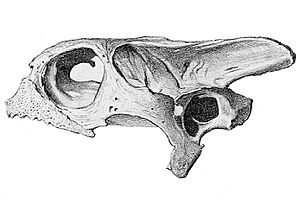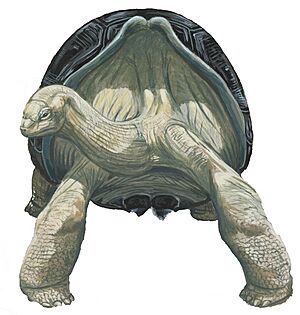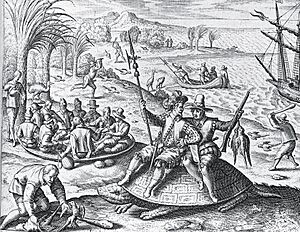Domed Mauritius giant tortoise facts for kids
Quick facts for kids Domed Mauritius giant tortoise |
|
|---|---|
 |
|
| Skull of Cylindraspis triserrata | |
| Conservation status | |
| Scientific classification | |
| Genus: |
Cylindraspis
|
| Species: |
triserrata
|
| Synonyms | |
|
|
The domed Mauritius giant tortoise (Cylindraspis triserrata) was a huge tortoise that used to live on the island of Mauritius. Sadly, this amazing creature is now extinct, meaning there are no more left alive. It was one of two types of giant tortoises found only on Mauritius.
About This Tortoise
This tortoise was one of two different giant tortoise species that lived only on Mauritius. This domed species likely ate mostly grass. It also enjoyed fallen leaves and fruits from the forest floor.
Its sister species probably ate leaves from higher branches. Even though they were about the same size, these two tortoise species looked quite different. The domed tortoise had a flatter, rounder shell. Its bones and shell were also thinner. The name triserrata means "three-toothed." This refers to three bony ridges on its lower jaw. These ridges might have helped it eat its specific diet.
Why They Disappeared
This tortoise species used to be very common all over Mauritius. They lived on the main island and on all the smaller islands nearby. Mauritius was the first of the Mascarene Islands to be settled by people. Because of this, it was also the first to lose many of its unique animals, including these tortoises.
Like many animals on islands, these tortoises were not afraid of humans. They were described as friendly and curious. When Dutch settlers arrived, they killed huge numbers of both tortoise species. They used the tortoises for food for themselves or their pigs. They also burned them to get fat and oil.
The settlers also brought new animals to the island. These included invasive species like rats, cats, and pigs. These new animals ate the tortoises' eggs and their baby hatchlings. The domed Mauritius giant tortoise likely disappeared from the main island by about 1700. By 1735, they were gone from most of the smaller islands too.
Last Refuge on Round Island
One of the Mauritius giant tortoise species might have survived longer on Round Island. This small island is just north of Mauritius. A report from 1846 said that some very large giant tortoises were still alive there in 1844. However, by then, Round Island was already full of many introduced rabbits.
In 1870, the Governor, Sir Henry Barkly, was worried about animals disappearing. He learned about the 1844 expedition from one of its members, Mr. William Kerr. Kerr told the Governor that another explorer, Mr. Corby, had found a female tortoise in a cave on Round Island. Corby brought it to Mauritius, where it had many babies. These baby tortoises were given to his friends.
The Governor could not find any of these baby tortoises. Even though a tortoise born in 1845 could have lived for a very long time, we don't know what happened to them.
Round Island was already damaged by the rabbits. Soon after, goats were also brought to the island. These new animals, or other problems, led to the complete extinction of the giant tortoises. This happened even in their last safe place. When the last of Corby's baby tortoises died, the species was completely gone forever.




